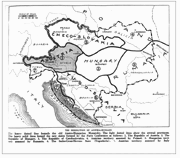
The Treaty of Trianon was the peace agreement signed in 1920, at the end of World War I, between the Allied Powers and Hungary. The treaty greatly redefined and reduced Hungary's borders. From its pre-1914 borders, it lost 72% of its territory, which was reduced from 325,111 sq km (125,526 sq mi) to 93,073 sq km (35,936 sq mi). It also lost 64% of its total population, which was reduced from 20.9 million to 7.6 million, and 31% (3.3 out of 10.7 million) of its ethnic Hungarians, who suddenly found themselves living outside the newly defined borders of Hungary. Hungary lost five of its ten most populous cities and was deprived of direct access to the sea and of some of its most valuable natural resources. The military establishment of the country was reduced to an army of about 35,000, while its navy ceased to exist. The principal beneficiaries of territorial adjustment were Romania, Czechoslovakia, and the Kingdom of Serbs, Croats and Slovenes. In addition, the newly established state of Hungary had to pay war reparations to its neighbours. The Hungarian delegation signed the treaty under protest on 4 June 1920 at the Grand Trianon Palace in Versailles, France.
Treaty of Trianon in The War That Came Early[]
The Treaty of Trianon was more hated by the Hungarians than the Treaty of Versailles was by the Germans. US consul Constantine Jenkins told Peggy Druce about the treaty as he attempted to explain to her the dangers of traveling to Hungary. Because of the sheer amount of territory lost in the treaty, Druce might find herself stranded in Hungary if the country declared war on any of her neighbors over land disputes.
| ||||||||||||||||||||||





